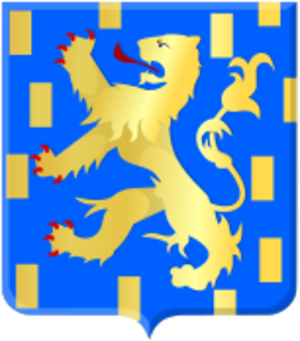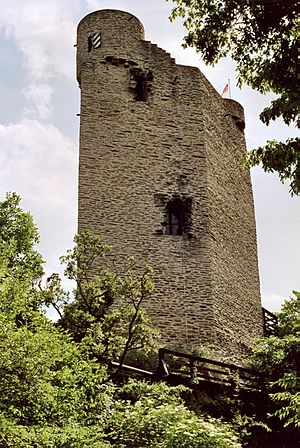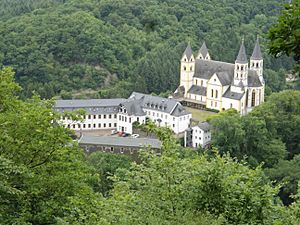Walram I, Count of Nassau facts for kids
Quick facts for kids
Walram I, Count of Nassau
|
|
|---|---|
| Born | c. 1146 |
| Died | 1 February 1198 (aged 51–52) |
| Noble family | House of Nassau |
| Spouse(s) | Kunigunde |
| Father | Rupert II of Laurenburg |
| Mother | ? |
Walram I of Nassau (born around 1146, died February 1, 1198) was an important leader, known as a Count. He is the earliest ancestor of the House of Nassau whose family line is completely clear. During his time as Count, he greatly expanded his lands. He also joined the Third Crusade, a big journey to the Holy Land. Walram was also known as Walram I of Laurenburg because he lived at Laurenburg Castle for a time.
Contents
Walram's Early Life
Walram was likely the son of Rupert II, Count of Laurenburg. We don't know for sure who his mother was.
Walram was first called the Count of Laurenburg between 1176 and 1191. Then, from 1193, he was known as the Count of Nassau. Even when the name Nassau was used, his family still used the Laurenburg title for a while. Walram ruled alongside his cousin, Rupert III. Later, he ruled with his son, Herman, whom he eventually took over from.
Expanding His Lands
Walram was very good at growing his family's territory. He gained control of several important areas as a fief (land given in exchange for loyalty) from the Landgraviate of Thüringen. These included the Herborner Mark, the Kalenberger Zent (which had towns like Mengerskirchen and Beilstein), and the Gericht Heimau (with Driedorf and Löhnberg).
This helped Walram connect his family's different properties. These included the Vogtship (a type of local rule) of Weilburg, the castles of Laurenburg and Nassau on the Lahn River, and the Vogtship in the Siegerland region. He also likely gained the Lordship of the Westerwald, which included places like Marienberg. Walram also bought the Vogtships of Koblenz and Ems.
To the south, Walram took over part of the Einrichgau. This area later became known as the Vierherrengericht (Four Lords’ Jurisdiction), with its main town of Marienfels. This land used to belong to the Counts of Arnstein. Walram's family had a claim to this land because an ancestor, Dudo of Laurenburg, had married a daughter of Count Louis I of Arnstein.
Walram became a supporter of Holy Roman Emperor Frederick I Barbarossa in 1179. He made his lands directly answerable to the German king, instead of the Archbishop of Trier. He remained a loyal supporter of the Hohenstaufen Emperors. Because of his strong ties with the Emperor, Walram was given control of the Königshof (royal court) in Wiesbaden. Around the same time, he also got hunting rights in the forests of the Rheingau. This meant his rule stretched over the Taunus mountains, all the way south to the Middle Rhine river.
Walram often had conflicts with his neighbors, including the families of Eppstein, Solms, and Katzenelnbogen.
A Trip to the Holy Land
Walram, along with his cousin Rupert III, joined the Third Crusade (1189–1190). He likely decided to go on the crusade with the Emperor at a big meeting in Mainz in March 1188.
At the start of the journey, Walram had an important job. He, his cousin Rupert, and Count Henry of Diez went with Bishop Herman II of Münster. They were sent as messengers to the Byzantine Emperor Isaac II Angelos in late 1188. The Emperor first ignored them, then held them as prisoners! They were set free only when the main crusade army got close. On October 28, 1189, Rupert and his companions rejoined the army.
Walram then disappears from the crusade records. It's not clear if he stayed with the army or returned home early. However, we know for sure that by 1190, before news of the Emperor's death reached Germany, Walram was back home. He was a witness to an important document in Cologne.
Later Years and Family
Not much is known about Walram's life after the crusade. He is sometimes mentioned as a witness in official documents, even imperial ones. However, he seems to have mostly stayed away from the Emperor's court and didn't join in many military actions.
On November 6, 1195, Walram made an important agreement with Bishop Henry I of Worms. This agreement, approved by Emperor Henry VI, set out the rights of both the bishop and the count over Weilburg Castle, the city, and the surrounding area. This was the first time Weilburg Castle and its lands were officially recognized as belonging to the House of Nassau.
After this agreement, Walram seems to have spent some time at the imperial court. He took part in a big meeting in Worms where the Emperor planned a new crusade. However, Walram did not join the German army for this crusade in 1197. Records show he stayed in the country.
Walram I died on February 1, 1198. He was buried at Arnstein Abbey. His sons, Henry II and Rupert IV, took over as Counts of Nassau after him.
Walram's Family
Walram married a woman named Kunigunde. She died on November 8, in or after 1198. She might have been the daughter of a count from Sponheim or Ziegenhain.
Walram and Kunigunde had three children:
- Henry II ‘the Rich’ (born around 1180, died between 1247 and 1250). He became Count of Nassau from 1198.
- Rupert IV (died after January 1, 1239). He was also Count of Nassau from 1198 until 1230, when he became a Teutonic Knight.
- Beatrix, who was mentioned in 1222 as a nun (a religious woman) in Affolderbach Abbey near Nastätten.




